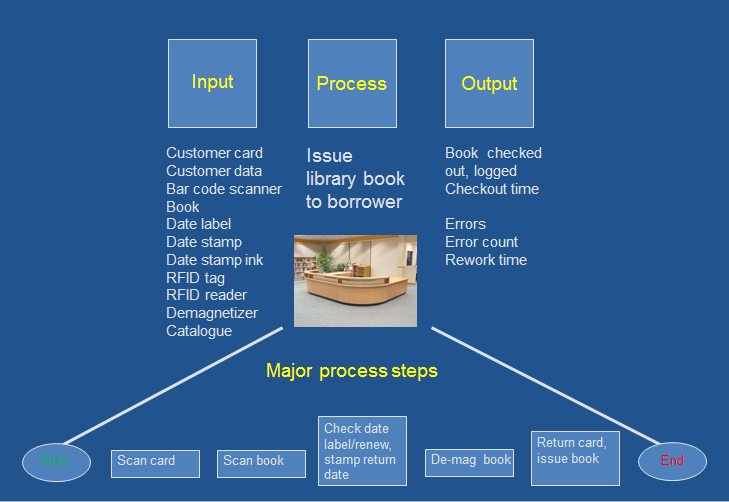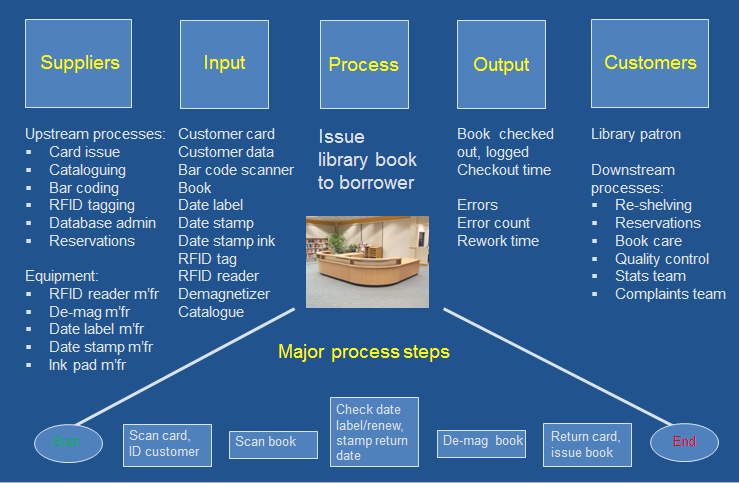We are probably most accustomed to the input-process-output (IPO) model in its application at the level of the operation, looking at resources in terms of the totality of raw materials and infrastructure required to produce a discrete product or service instance for an end customer, with the transformation stage representing an entire operation – that is, the sum total of processes which occur in individual factory or service shop.
However, at the level of individual processes the IPO model remains useful. We can conceive of the customer not merely as the end customer – the person who will pay for, and take delivery of, a product or service – but as the customer ‘side’ of the operation. This will certainly include ‘downstream’ processes which receive partially transformed resources from ‘upstream’ processes. We can also call these upstream processes the supply side. Obviously, these descriptions are relative: the designation of neighbouring processes as ‘upstream’ or ‘downstream’ depends on exactly which process within an operation we are looking at.
Breaking down a work operation in this way is a particularly useful way of emphasizing the importance of the customer perspective which is so important in statistical process control, and of course in continuous improvement more generally.
The public library as a ‘service shop’
Let us consider a relatively common service operation: that of a public library. Clearly, there are many separate processes which contribute to the overall function of this operation. There will be processes dedicated to purchasing new stock and retiring or selling old stock; enrolling and issuing cards to new customers; tracking loans and if necessary levying fines for late or lost books; cataloguing books, and shelving or re–shelving them. There will of course also be processes involved in heating, lighting, securing, and maintaining the library building itself.
It is well beyond our scope here to consider all of these processes, so let us just look at one – the issue of a library book to a borrower:

IPO analysis at the process level requires us to consider ‘neighbouring’ processes
One of the great advantages in applying the IPO model to a single process in this way is that it forces us to think about how processes should be defined in relation to each other. For example, it is fairly clear, given the logical flow of process steps and the necessary co-location of resources involved in issuing a library book to a borrower, that this should be considered a discrete process. But what if the borrower has to pay an outstanding fine before a book can be issued? Should the resources and activities involved in ascertaining the fine, taking money – perhaps in cash or by card – recording payment, and issuing a receipt, be considered part of the book issuing process? Or should it be considered a separate process? There really is no clear answer to this question. It depends on many factors, including the policies of a particular library, and regulations which underlie them; the training and deployment of staff; and of course customer preferences. The volume of flow through the process will also be very significant. Where volume is high, it is possible to create ‘short fat’ processes which have high throughput rates, low throughput time, and high specialization. Where volume is low – for example, in a branch library belonging to a small village – it may be more appropriate to create ‘long thin’ processes which take account of the lower volume of customers, as well as limitations on staff and resources.
SIPOC extends IPO analysis to customers and suppliers
The IPO model, when applied to processes, can be extended to cover the suppliers to, and customers of, the process. As already indicated, the suppliers to our book issuing process are not merely the suppliers of equipment and resources. There will also be those processes within the library operation which have to do their work before the book issuing process can occur. These are the upstream or supplier processes. Similarly, although the library patron is the end customer of the library as a whole, and he or she is directly involved in the book issuing process, the library patron is not the only customer of the book issuing process. There will be downstream processes essential to the smooth functioning of the library operation as a whole, which will depend on high quality processing by, and outputs from, the book issuing process. For example, if the library patron instantly changes his or her mind about borrowing a particular book once it has been issued, it will need to be reworked by the issuing process, and passed on to the re-shelving team in an efficient way. If library patrons already have books on loan to them, and they bring them back to the library for loan renewal and re-issue, it may be the case that particular books have been reserved by other patrons. In this case, reserved books will need to be returned and passed on to the reservations team so that the relevant patrons can be alerted. In this particular case, the reservations team will also need to have a mechanism for alerting the issue team to the existence of particular reservations. In this scenario, the reservations team is both the supplier to, and the customer of, the issue team.

SIPOC enforces ‘customer orientation’
One of the most valuable properties of SIPOC analysis is that it mandates a customer orientation throughout an entire operation, even for those processes which have no contact with the end customer or service user. It also helps greatly in working out the order of individual processes within a larger operation. In the case of our library example, it immediately becomes clear that the reservations process and the book issuing process are related in a more complex way than might at first be thought.
SIPOC only works when major process steps are identified and correctly ordered
One of the key determinants of success when using SIPOC analysis is to ensure that the major process steps have been identified and correctly ordered. In the above example of the book issuing process in a public library, the process has five principal steps or activities. This is probably about the right number. Ideally, the major process steps in SIPOC analysis should number between five and seven. It is of course possible that there will be subsidiary activities related to each process step, but these will typically be minor, self-limiting, and/or unconnected with other processes in a direct way. For example, in the first step of our book issuing process, it is conceivable that the activity of scanning the customer’s card will reveal the card to be worn or dirty and requiring replacement; or possibly the member of library staff might notice some missing or incorrect data in the borrower’s electronic file. In both of these cases, it will be necessary to communicate with an upstream process to inform its owners of the need for rework. However, this communication is only necessary for the purpose of telling the upstream processes about the need to re-work activities which arise within their processes. It is not intrinsic or essential to the activity of scanning the customer’s card and checking his or her identity.